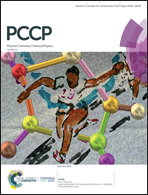Work function of GaAs(hkl) and its modification using PEI: mechanisms and substrate dependence†
Abstract
Spin-coating of poly(ethylenimine) (PEI) has been used to reduce the work function of GaAs (001), (110), (111)A and (111)B. The magnitude of the reduction immediately after coating varies significantly from 0.51 eV to 0.69 eV and depends on the surface crystal face, on the GaAs bulk doping and on the atomic termination of the GaAs. For all samples, the work function reduction shrinks in ambient air over the first 20 hours after spin coating, but reductions around 0.2–0.3 eV persist after 1 year of storage in air. Core-level photoemission of thin film PEI degradation in air is consistent with a two-stage reaction with CO2 and H2O previously proposed in carbon capture studies. The total surface dipole from PEI coating is consistent with a combination of internal neutral amine dipole and an interface dipole whose magnitude depends on the surface termination. The contact potential difference measured by Kelvin probe force microscopy on a cleaved GaAs heterostructure is smaller on p-doped regions. This can be explained by surface doping due to the PEI, which increases the band bending on p-doped GaAs where Fermi level pinning is weak. Both surface doping and surface dipole should be accounted for when considering the effect of PEI coated on a semiconductor surface.



 Please wait while we load your content...
Please wait while we load your content...